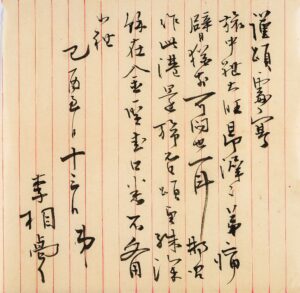Throughout history, across both East and West, there is a consensus that one’s character or inner self is revealed through handwriting. By examining someone’s writing, we can gauge the quality of their character. If I were to select the most outstanding figure in terms of handwriting during the Japanese occupation of Korea, without hesitation, I would choose independence activist Yi Sang-seol. When I published *The Handwriting Speaks* in 2009, I was surprised to see the cover designer, purely admiring the artistic beauty, choose Lee Sang-seol’s handwriting for the cover.
According to a confidential report by Akashi Motojiro, the military police commander responsible for the early suppression of independence fighters during the Japanese occupation, Ahn Jung-geun sought out Lee Sang-seol, who was then engaged in anti-Japanese educational activities, and became his disciple. Ahn also named Lee as the person he respected the most. Toward the end of the report, a passage appears from the interrogation of Ahn by Sakai, a police officer affiliated with the Residency-General of Korea: “His ambition is vast, and he has a profound understanding of the world’s affairs, penetrating the situation in the East. Even if many people were gathered, none could match Sang-seol. He possesses great capacity, insight, and the qualities of a leader, worthy of being a statesman.”
What makes Lee Sang-seol’s handwriting the best, and why does it reflect his extraordinary character? His script flows elegantly, full of vigor, indicating an active mind and abundant inner energy. The large size of his characters suggests courage and sociability. Long horizontal strokes imply patience, while the elongated strokes at the end of words symbolize great strength and vitality. The wide spacing between lines shows he was considerate of others. While many individuals may display these traits, Lee Sang-seol’s handwriting transcends them. The balanced combination of straight and curved lines reflects both rationality and integrity, coupled with a sense of generosity. Despite variations in size, angle, and slant, his script never strays too far, suggesting he was innovative yet principled, maintaining discipline without being confined by it. To reach the highest level, one must possess intelligence, judgment, courage, patience, energy, uprightness, and consideration—qualities Lee had, along with innovation, restraint, and moderation.

